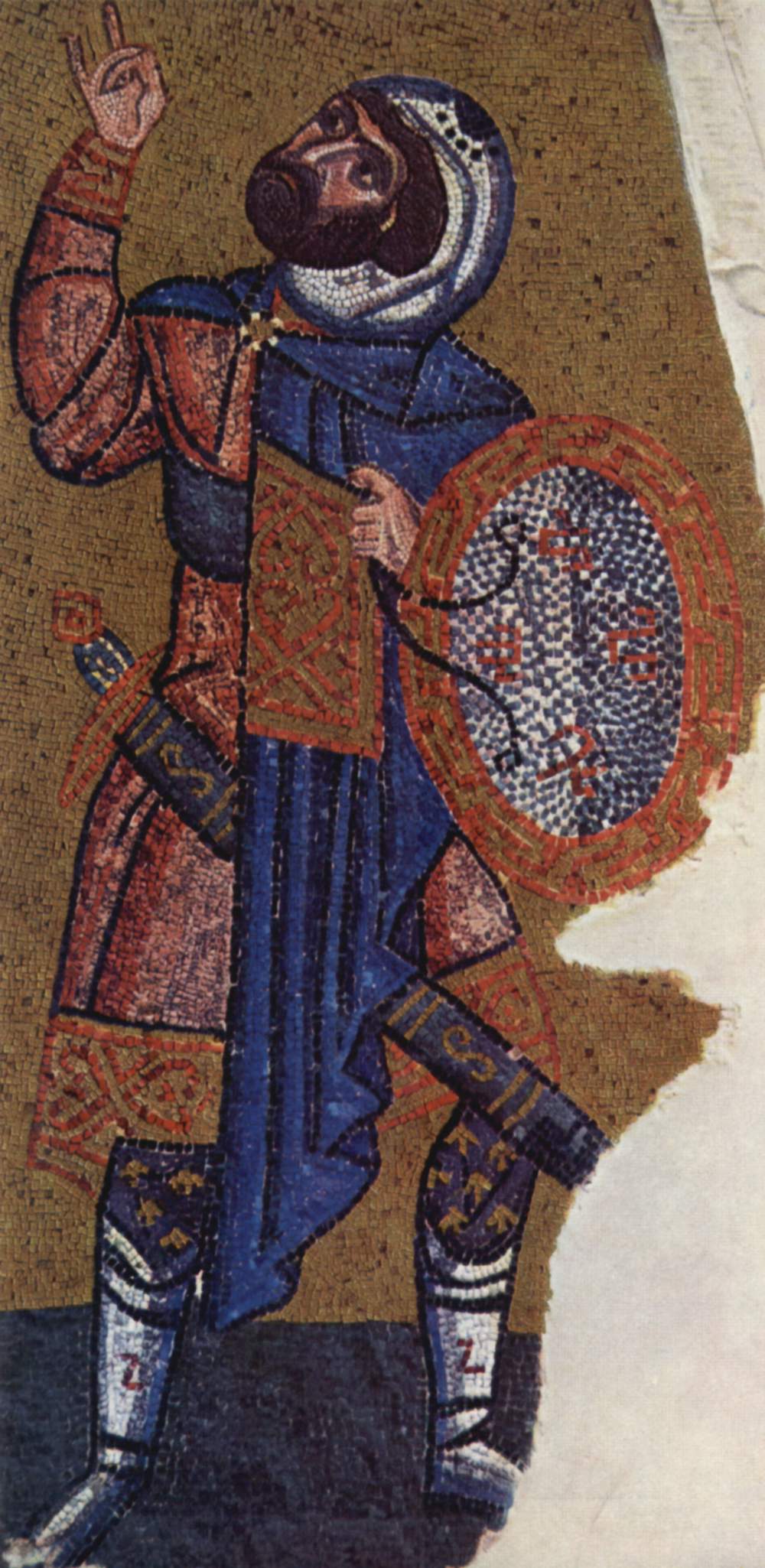 |
| Via Wikipedia (Nice large image available) |
About two seconds after Mistress Clare received her Laurel, her husband got called up and put on contemplation for Elevation to the Order of the Chivalry. I very much wanted to help, but I was pretty wrapped up in getting things accomplished for Fiametta's Elevation that was happening two weeks before his Vigil. So, this was a panic project.
Clare said that he very much wanted to have the outfit that St. Longinus is depicted as wearing in an 11th century mosaic at Nea Moni church. She was working on gold leafing the pants and had been embroidering on his undertunic and was about to tackle the trim on the tunic, but didn't have wool nor time to make the cloak.
I couldn't find the right blue wool either, so my first order of business was to dye the periwinkle purple wool I bought. I'd planned to overdye with brown in order to mute the purple, but at the advice of my friend Tabitha, I decided to try color remover first. It tamed the brightness of the purple, and when I dyed the wool (which was now nice and fulled) dark navy, I got a beautiful bright, true blue.
Next up was cutting the cloak. This is actually a chlamys, a type of Greek cloak shaped like a trapezoid. Great shape and it gives a lovely drape. I cut a large rectangle, and then added triangular side sections. This is the basic layout. Since I didn't plan to line the wool, and didn't want seams showing, I did an abutted seam. The fulled edges were just pushed together without an overlap. It kept them pretty invisible.
I had a couple of ideas for the tablions (the rectangle parts) but settled on applique due to time constraints. There are two-- one on each side, in case that isn't evident. I am pretty militant about doing applique in a period manner with edges sandwiched under cording, rather than satin stitched or turned under, as is more modernly used. Unfortunately, there was just no damn way I was going to get it couched down by hand in time. So, I'm going to put my hand over my face and peer through the fingers as I admit I machine couched the cording down. And that I bought the cording instead of made it (which was probably a mistake since it was hard to deal with and unraveled like crazy.) Anyway, I cut the heart/palmette out of gold silk, and couched it down onto red silk. Then it was appliqued to the wool.
 The last thing to worry about was a way to close it. If I'd had nothing but time and the metalworking skills, the proper type of pin for this cloak would have been a bow fibula. It was a popular type for centuries. I had an hour before I had to drive up to the event. . . So, I punted. I mentioned this was a panic project. right? What I did was take a kilt pin from the craft store (available in the notions department near the safety pins) and a carved stone pendant with a gryphon on it. A few years ago I had used some metal pendants to make quick and dirty tortoise brooches for a Viking apron dress. Since I didn't want to risk my dress falling down due to inadequate glue, I fused the pin to the back of the pendant using plumber's epoxy. It is a putty available at any hardware store. You just knead it until it is a consistent color, smooth it into place, and it dries like steel in 20 minutes. Even works underwater. In this case, I used enough putty to create a faux bezel around the pendant and full embedded the pin.
The last thing to worry about was a way to close it. If I'd had nothing but time and the metalworking skills, the proper type of pin for this cloak would have been a bow fibula. It was a popular type for centuries. I had an hour before I had to drive up to the event. . . So, I punted. I mentioned this was a panic project. right? What I did was take a kilt pin from the craft store (available in the notions department near the safety pins) and a carved stone pendant with a gryphon on it. A few years ago I had used some metal pendants to make quick and dirty tortoise brooches for a Viking apron dress. Since I didn't want to risk my dress falling down due to inadequate glue, I fused the pin to the back of the pendant using plumber's epoxy. It is a putty available at any hardware store. You just knead it until it is a consistent color, smooth it into place, and it dries like steel in 20 minutes. Even works underwater. In this case, I used enough putty to create a faux bezel around the pendant and full embedded the pin.
This may not have been my best project ever, and it certainly wasn't my most historically accurate, but sometimes my costumer's skills come in handy. From 5 feet away it looked amazing. Between the white boots he was wearing, the amazing outfit his wife crafted him, and the blue and red cloak, Sir Ronan looked pretty much like a Byzantine superhero as he became a knight.